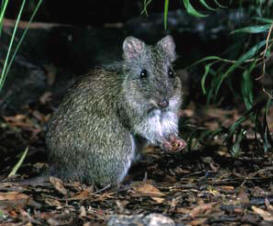 |
|

Potorous
gilbertii
Description
A medium-sized mammal slightly smaller than
a rabbit and bearing some resemblance to a
bandicoot, Gilbert's Potoroo has a dense
coat of soft grey-brown fur. The tail is
lightly furred, and curls up tightly when
the animal is at rest. When standing, the
animal has a hunched appearance and its eyes
appear to look obliquely upwards. The sides
of the face are furred giving the appearance
of heavy jowls and the snout is slender,
curving slightly downwards as in other
potoroos. The ears are rounded and almost
completely buried in the fur.
The forefeet have long curved claws, forming
strong digging appendages that are also able
to handle food items with great dexterity.
The hindfeet are long, as in the other
members of the kangaroo family. Gilbert's
Potoroos place their fore-feet on the ground
when moving slowly, but hop on their
hindfeet when moving rapidly.
-
Weight: Adult males, 1100g, adult
females 900g
-
Head and body length 270 mm
-
Tail length 210 mm
|

Potoroo photos
courtesy of Dick Walker
Information thanks to :-
Gilberts Potoroo Action Group
http://www.potoroo.org/index.html
|
|
|

Potorous gilbertii
|
Potoroos
belong to a small family called the
Potoroidae
(rat-kangaroos), within the large
superfamily
Macropodoidea.
The rat-kangaroos are small marsupials
which hop on their hindfeet, dig for
much of their food with well-developed
forefeet, and have a complex stomach
that allows them to extract nutrition
very efficiently from
their diet. The
Potoroidae
contains several small genera, including
Bettongia,
(the bettongs,
such as the burrowing bettong and the
brush-tailed bettong) and
Potorous,
containing the potoroos.
Altogether, five types of potoroo have
been described. Two of these,
Potorous
tridactylus apicalis,
from Tasmania, and
Potorous
tridactylus tridactylus,
from South-eastern Australia, are
regarded as subspecies of the Long-nosed
Potoroo
P.tridactylus.
In wet forests of Gippsland in Victoria
and southern New South Wales, a few
hundred Long-footed Potoroos
Potorous
longipes
hang tenuously onto existence. The
Broad-faced Potoroo
Potorous
platyops
was the only potoroo known to live in
semi-arid habitats, but no living
animals have been recorded since the
1870s, although the sub-fossil remains
that have been found show that it was
widely distributed in southern and
western coastal parts of Australia.
Gilbert's Potoroo
Potorous
gilbertii
is the fifth member of this exclusive
group. |
Threatening Processes
The most
significant threats to the survival of
Gilbert's Potoroo have been identified
as:
Fire
The only known wild population of
Gilbert's Potoroo exists in dense, long
unburnt vegetation that is potentially
highly vulnerable to wildfire. Fire
exclusion is thus an extremely high
priority in the protection of the wild
population. The captive colony was
established at least partly to provide
insurance against the loss of the single
known population through a catastrophic
fire event.
Feral
predators
Gilbert's Potoroo is within the Critical
Weight Range (35g to 5kg) of mammals
thought to be most susceptible to
decline. It is in the prey size range of
both Foxes and Cats, both of which are
known to occur in the Two Peoples Bay
area. Dietary analysis of the gut
contents and faeces of a feral Cat
trapped at Mt Gardner in 2001 revealed
that it had consumed both Quenda
(Bandicoot) and Noisy Scrub-bird.
Control of feral Cats would thus also be
beneficial to other threatened mammals
and birds in the area.
Dieback
disease Phytophthora cinnamomi
Potoroos are believed to be present only
in areas of the Reserve that are free of
Dieback infection which can cause
considerable changes to the floristic
structure of the habitat. Gilbert's
Potoroo feeds primarily on hypogeal
fungi, many of which are mycorrhizal.
Plant dieback disease is considered to
be a major threat to the continued
survival of the potoroo by altering
vegetation structure or eliminating
species that are hosts to the
mycorrhizal fungi on which they feed.
Clearing
of vegetation adjacent to Two Peoples
Bay
The population of Gilbert's Potoroo on
the Mount Gardner headland has the
potential to expand through the
dispersal of young through adjacent
bushland corridors into suitable habitat
nearby (especially near Mount
Manypeaks). Some of this linking
bushland occurs on private land. Unless
these corridors are protected from
clearing, the chance of successful
dispersal to new areas will be very
small.
|
For further information or
details of what you can do please visit
http://www.potoroo.org/index.html
|
|
|

